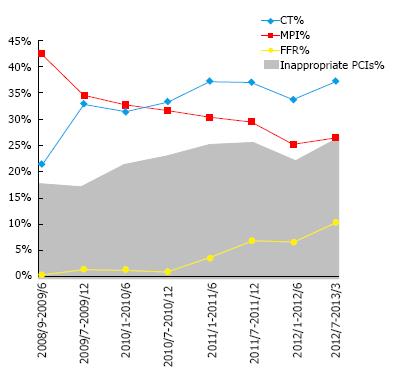Copyright
©The Author(s) 2016.
World J Cardiol. Aug 26, 2016; 8(8): 456-463
Published online Aug 26, 2016. doi: 10.4330/wjc.v8.i8.456
Published online Aug 26, 2016. doi: 10.4330/wjc.v8.i8.456
Figure 1 The rates of inappropriate percutaneous coronary intervention in non-acute settings in Japan and in the United States.
In Japan, when evaluated under the original criteria developed in 2009 (AUC/2009), 15% of PCIs were categorized as inappropriate, and 30.7% of PCIs were classified as inappropriate under the revised criteria (AUC/2012) (blue bars). By contrast, in the United States, 11.6% of PCIs were deemed to be inappropriate by AUC/2009, and when using the AUC/2012, 26.2% of PCIs were classified as inappropriate (red bars). Additionally, the rates of inappropriate PCI decreased by half from 2009 to 2014, owing to the publication of AUC. PCI: Percutaneous coronary intervention; AUC: Appropriate use criteria.
Figure 2 The variability of inappropriate ratings in elective percutaneous coronary interventions among institutes participating in the JCD-KiCS registry (15 centers).
When the current AUC (developed in 2012) was applied to the JCD-KiCS registry, 30.7% of elective PCIs were classified as having inappropriate indications. This rate varied across institutes, ranging from 17.5% to 50%. AUC: Appropriate use criteria; PCI: Percutaneous coronary intervention.
Figure 3 Association between temporal trends in non-invasive tests and frequency of inappropriate ratings.
The proportion of patients evaluated with CCTA and FFR substantially increased (both P for trend < 0.001), which coincided with a decrease in utilization of stress myocardial perfusion imaging over the course of 5 years (P for trend < 0.001). Contemporaneously, the proportion of inappropriate PCIs increased (P for trend = 0.003) in parallel with the increase in utilization of CCTA. The gray area indicates the percentages of inappropriate procedures based on original appropriateness criteria (AUC/2009). From Inohara et al[17]. CCTA: Coronary computed tomography angiography; MPI: Myocardial perfusion imaging; FFR: Functional flow reserve.
- Citation: Inohara T, Kohsaka S, Ueda I, Yagi T, Numasawa Y, Suzuki M, Maekawa Y, Fukuda K. Application of appropriate use criteria for percutaneous coronary intervention in Japan. World J Cardiol 2016; 8(8): 456-463
- URL: https://www.wjgnet.com/1949-8462/full/v8/i8/456.htm
- DOI: https://dx.doi.org/10.4330/wjc.v8.i8.456











